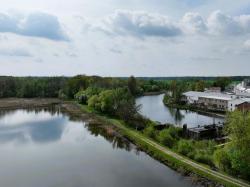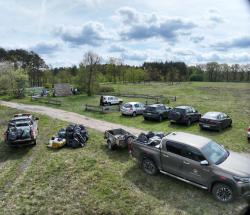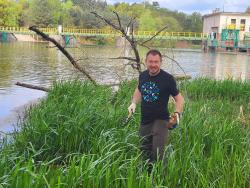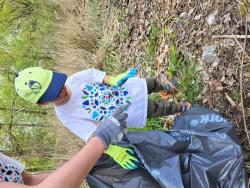 Asset Publisher
Asset Publisher
Polish forests
Poland is in the European lead, while concerning the area of all forests. They cover about 29,2 % of the country territory, and grow within the area of 9,1 million hectares. The overwhelming majority of the forests is state owned, of which almost 7,6 million hectares are managed by the State Forests National Forest Holding..
The number of Polish forest is still growing. The forestation rate of the country has increased from 21 % in 1945 to 29,2 % at the moment. Between 1995 and 2008, the forest area increased by 310 thousand ha. The basis for afforestation works is the "National Programme for Increasing the Forest Cover" (KPZL), assuming an increase of the forestation rate up to 30 % by 2020 and up to 33 % by 2050. Polish forests abound in flora, fauna and fungi. 65 % of the total number of animal species live there.
The forests grow in our country on poor soils, mainly because of the development of the agriculture in previous years. It influences the distribution of the types of the forest sites in Poland. Over 55 % of the forest areas is covered with coniferous forests. In other areas, there are forest sites, mainly the mixed ones. Their small part constitute alder and riparian forests – not more than 3 %.
In the years 1945 – 2011 the area of natural deciduous tree stands within the area of the State Forests National Forest Holding increased from 13 to 28,2 %.
Within the lowlands and uplands the most often occurring tee species is pine. It covers 64,3 % of the forest area of the State Forests National Forest Holding and 57,7 % of private and commune forests. In the mountains the predominant species is European spruce ( in the west) and European spruce with beech (in the east). Domination of pine is the result of carrying on sustainable forest management in the past. Once, the monocultures (crops or cultivations of one species) were the answer to the great demand of industry for wood. Such forests appeared to be quite fragile to climatic factors. They also were often the prey of pests' expansion.
In Polish forests, the share of other tree species, especially deciduous trees have been systematically increasing. The foresters have stepped aside from monocultures – that is why, they try to fit specific species of the forest stand to the natural stand, that would be proper for the given area. Thanks to that, in the years 1945 – 2011, the area of the deciduous tree stands within the lands of the State Forests National Forest Holding increased from 13 to 28,2 %. There occur more and more frequently the following tree species: oaks, ashes, maples, sycamore maples, elms, but also birches, beeches, alders, poplars, hornbeams, aspens, tilias and willows.
Our forests are the most often represented by the forest stands aged 40 to 80 years. The average age of the forest equals 60 years. More and more trees are of big size at the age over 80 years. Since the end of the Second World War, the forests' area has increased up to almost 1,85 million hectares.
Raport o stanie lasów w Polsce 2012
 Asset Publisher
Asset Publisher
OPERACJA CZYSTA RZEKA W DRUGIEJ ODSŁONIE
OPERACJA CZYSTA RZEKA W DRUGIEJ ODSŁONIE
Pracownicy Nadleśnictwa Wymiarki w ramach obchodów Światowego Dnia Ziemi włączyli się w 6 edycję operacji Czysta Rzeka.
Inicjatywa ta funkcjonuje od 2019 r. i jest największą akcją społecznego sprzątania rzek w Polsce, która działa w oparciu o powołane Sztaby Lokalne.
W bieżącym roku pracownicy Nadleśnictwa Wymiarki zarejestrowali sztab lokalny pn. Czysta Nysa Łużycka. Była to już druga odsłona przedmiotowej akcji realizowana na trenie nadleśnictwa. Debiut naszych działań miał miejsce w 2023 r.
Celem akcji jest zwrócenie uwagi społeczeństwa na konieczność dbania o otaczającą człowieka przyrodę oraz sprzątanie śmieci z rzek, ich linii brzegowych oraz okolicy.
W sobotnie popołudnie pracownicy nadleśnictwa wraz z rodzinami przystąpili do sprzątania linii brzegowej Nysy Łużyckiej przepływającej w okolicach miejscowości Sobolice, stanowiącej jednocześnie granicę państwa. W inicjatywie uczestniczyła również osobiście Pani Ewelina Rzepka – Wójt Gminy Przewóz, na terenie której realizowane było sprzątanie.
W efekcie podniesione śmieci trafiły do 67 worków o pojemności 120 litrów każdy. W nadrzecznych szuwarach odnaleziono również porzucone dwie lodówki! Objętość zebranych śmieci to ponad 7 metrów sześciennych, czyli pełny kontener wywożony przez śmieciarki. Podkreślenia wymaga fakt, że tak duże ilości śmieci zebrano na odcinku zaledwie 3 km rzeki.

Nasze działania pozwoliły na zaprezentowanie właściwej odsłony walorów przyrodniczych otoczenia rzeki oraz wyeliminowały odpady ze środowiska.
Operacja Czysta Rzeka w liczbach stan na 17.04.2024r.:
- 20 500 uczestników w całej Polsce
- 791 lokalnych akcji sprzątania
- 141 ton uprzątniętych odpadów
Dziękujemy wszystkim uczestnikom „wiosennych porządków” za zaangażowanie i wspólnie spędzony czas.
Podsumowaniem zorganizowanego wydarzenia mogą stanowić słowa jednej z uczestniczek „młodego pokolenia”, 5-letniej Nadii, która stwierdziła na zakończenie: „Teraz już będzie tutaj ładnie i czysto.”
Zachęcamy do włączenia się do przedmiotowej inicjatywy wszystkich ludzi czynu oraz społeczności lokalne, którym otaczająca nas przyroda nie jest obojętna.
Spotkajmy się nad rzeką i zróbmy coś dla Ziemi !!!
Autor J.Karwański/J.Kazimir


 fot. Paweł Fabijański
fot. Paweł Fabijański
 fot. Paweł Fabijański
fot. Paweł Fabijański
 fot. Paweł Fabijański
fot. Paweł Fabijański


 foto. J.Kazimir
foto. J.Kazimir
 foto. J.Kazimir
foto. J.Kazimir
 foto. S.Wójtowicz
foto. S.Wójtowicz
 foto. J.Kazimir
foto. J.Kazimir



